Analysis of Operations Management Approaches in Car Manufacturing
VerifiedAdded on 2020/06/04
|16
|5434
|94
Report
AI Summary
The report examines the application of six distinct operations management approaches within a UK-based car manufacturing firm. These methods include strategic planning for market competition, lean manufacturing to reduce waste, total quality management (TQM) to enhance product quality and customer satisfaction, Six Sigma techniques for error minimization, just-in-time (JIT) inventory systems to manage stock levels efficiently, and supply chain integration to streamline operations from procurement to distribution. Each approach is analyzed in terms of its contribution to the firm's enhanced productivity and profitability. The report concludes with recommendations for managers and leaders on evaluating internal and external factors to make informed decisions that bolster the company's market position.
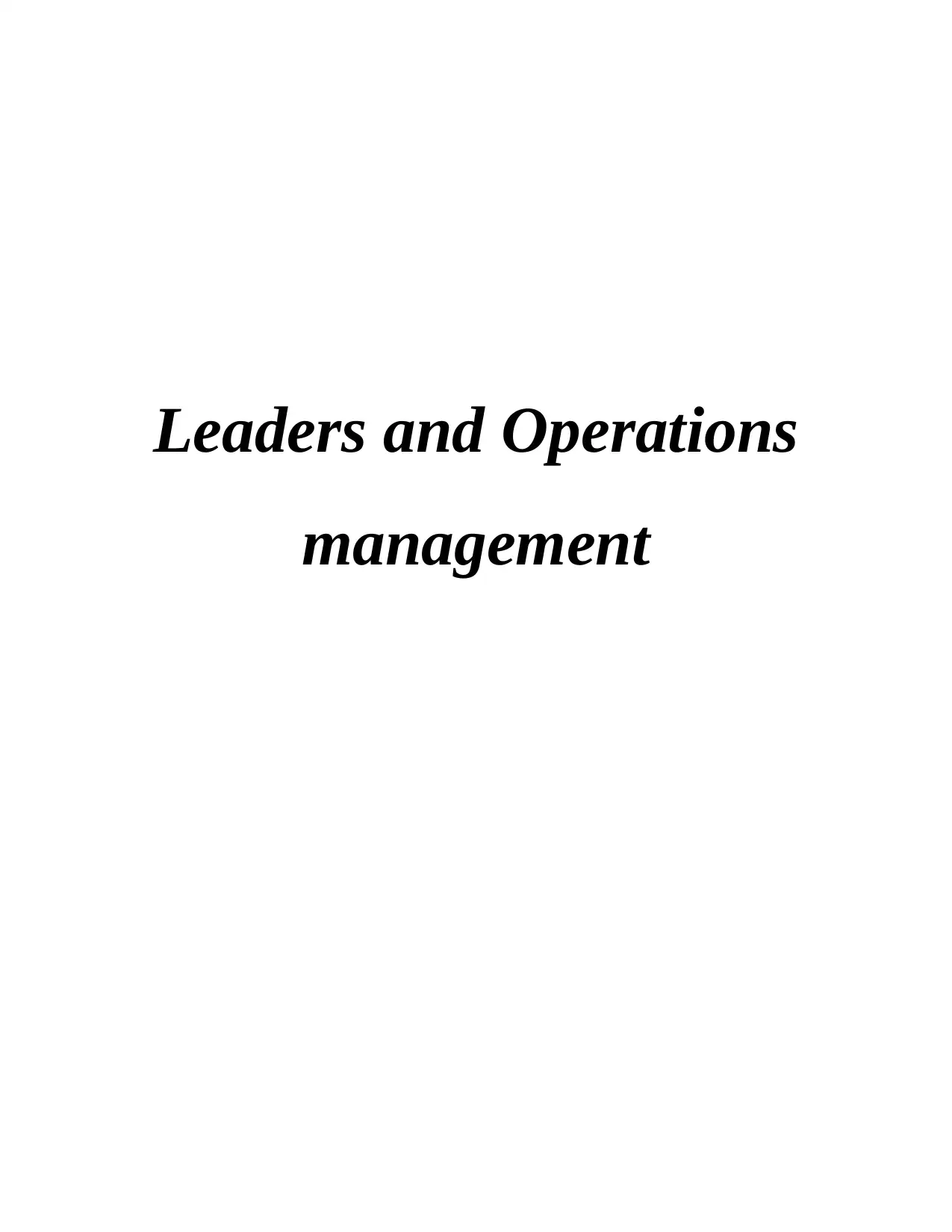
Leaders and Operations
management
management
Paraphrase This Document
Need a fresh take? Get an instant paraphrase of this document with our AI Paraphraser
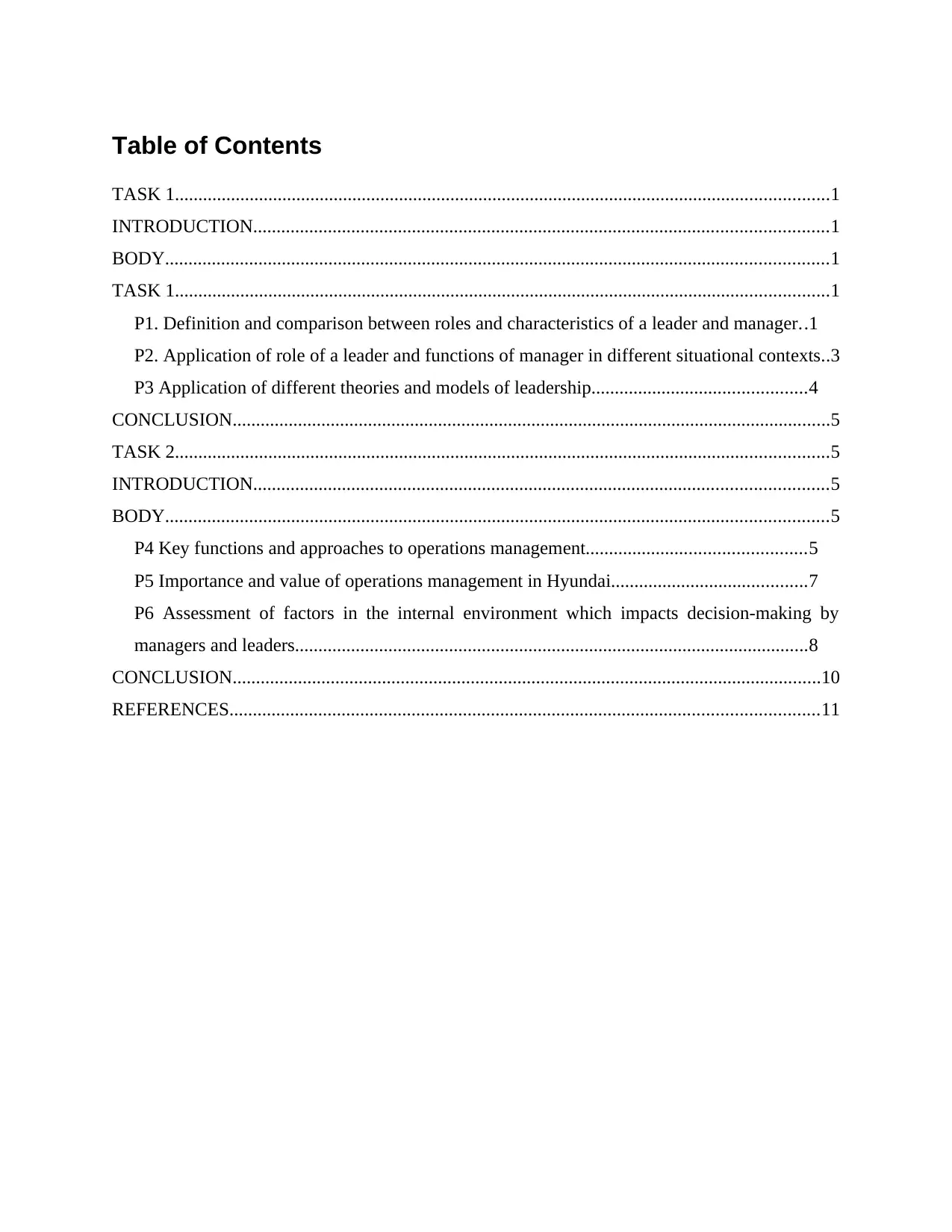
Table of Contents
TASK 1............................................................................................................................................1
INTRODUCTION...........................................................................................................................1
BODY..............................................................................................................................................1
TASK 1............................................................................................................................................1
P1. Definition and comparison between roles and characteristics of a leader and manager..1
P2. Application of role of a leader and functions of manager in different situational contexts..3
P3 Application of different theories and models of leadership..............................................4
CONCLUSION................................................................................................................................5
TASK 2............................................................................................................................................5
INTRODUCTION...........................................................................................................................5
BODY..............................................................................................................................................5
P4 Key functions and approaches to operations management...............................................5
P5 Importance and value of operations management in Hyundai..........................................7
P6 Assessment of factors in the internal environment which impacts decision-making by
managers and leaders..............................................................................................................8
CONCLUSION..............................................................................................................................10
REFERENCES..............................................................................................................................11
TASK 1............................................................................................................................................1
INTRODUCTION...........................................................................................................................1
BODY..............................................................................................................................................1
TASK 1............................................................................................................................................1
P1. Definition and comparison between roles and characteristics of a leader and manager..1
P2. Application of role of a leader and functions of manager in different situational contexts..3
P3 Application of different theories and models of leadership..............................................4
CONCLUSION................................................................................................................................5
TASK 2............................................................................................................................................5
INTRODUCTION...........................................................................................................................5
BODY..............................................................................................................................................5
P4 Key functions and approaches to operations management...............................................5
P5 Importance and value of operations management in Hyundai..........................................7
P6 Assessment of factors in the internal environment which impacts decision-making by
managers and leaders..............................................................................................................8
CONCLUSION..............................................................................................................................10
REFERENCES..............................................................................................................................11
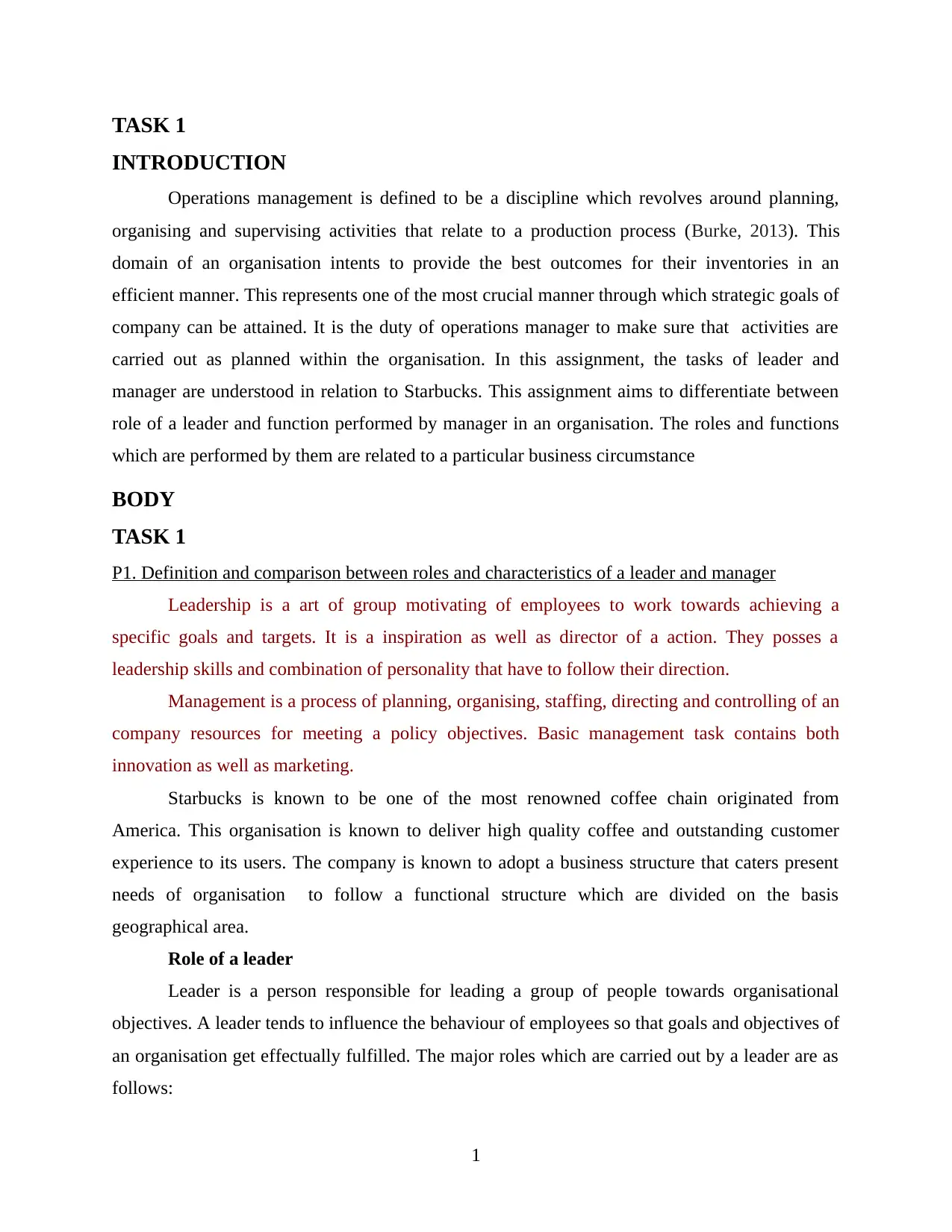
TASK 1
INTRODUCTION
Operations management is defined to be a discipline which revolves around planning,
organising and supervising activities that relate to a production process (Burke, 2013). This
domain of an organisation intents to provide the best outcomes for their inventories in an
efficient manner. This represents one of the most crucial manner through which strategic goals of
company can be attained. It is the duty of operations manager to make sure that activities are
carried out as planned within the organisation. In this assignment, the tasks of leader and
manager are understood in relation to Starbucks. This assignment aims to differentiate between
role of a leader and function performed by manager in an organisation. The roles and functions
which are performed by them are related to a particular business circumstance
BODY
TASK 1
P1. Definition and comparison between roles and characteristics of a leader and manager
Leadership is a art of group motivating of employees to work towards achieving a
specific goals and targets. It is a inspiration as well as director of a action. They posses a
leadership skills and combination of personality that have to follow their direction.
Management is a process of planning, organising, staffing, directing and controlling of an
company resources for meeting a policy objectives. Basic management task contains both
innovation as well as marketing.
Starbucks is known to be one of the most renowned coffee chain originated from
America. This organisation is known to deliver high quality coffee and outstanding customer
experience to its users. The company is known to adopt a business structure that caters present
needs of organisation to follow a functional structure which are divided on the basis
geographical area.
Role of a leader
Leader is a person responsible for leading a group of people towards organisational
objectives. A leader tends to influence the behaviour of employees so that goals and objectives of
an organisation get effectually fulfilled. The major roles which are carried out by a leader are as
follows:
1
INTRODUCTION
Operations management is defined to be a discipline which revolves around planning,
organising and supervising activities that relate to a production process (Burke, 2013). This
domain of an organisation intents to provide the best outcomes for their inventories in an
efficient manner. This represents one of the most crucial manner through which strategic goals of
company can be attained. It is the duty of operations manager to make sure that activities are
carried out as planned within the organisation. In this assignment, the tasks of leader and
manager are understood in relation to Starbucks. This assignment aims to differentiate between
role of a leader and function performed by manager in an organisation. The roles and functions
which are performed by them are related to a particular business circumstance
BODY
TASK 1
P1. Definition and comparison between roles and characteristics of a leader and manager
Leadership is a art of group motivating of employees to work towards achieving a
specific goals and targets. It is a inspiration as well as director of a action. They posses a
leadership skills and combination of personality that have to follow their direction.
Management is a process of planning, organising, staffing, directing and controlling of an
company resources for meeting a policy objectives. Basic management task contains both
innovation as well as marketing.
Starbucks is known to be one of the most renowned coffee chain originated from
America. This organisation is known to deliver high quality coffee and outstanding customer
experience to its users. The company is known to adopt a business structure that caters present
needs of organisation to follow a functional structure which are divided on the basis
geographical area.
Role of a leader
Leader is a person responsible for leading a group of people towards organisational
objectives. A leader tends to influence the behaviour of employees so that goals and objectives of
an organisation get effectually fulfilled. The major roles which are carried out by a leader are as
follows:
1
⊘ This is a preview!⊘
Do you want full access?
Subscribe today to unlock all pages.

Trusted by 1+ million students worldwide
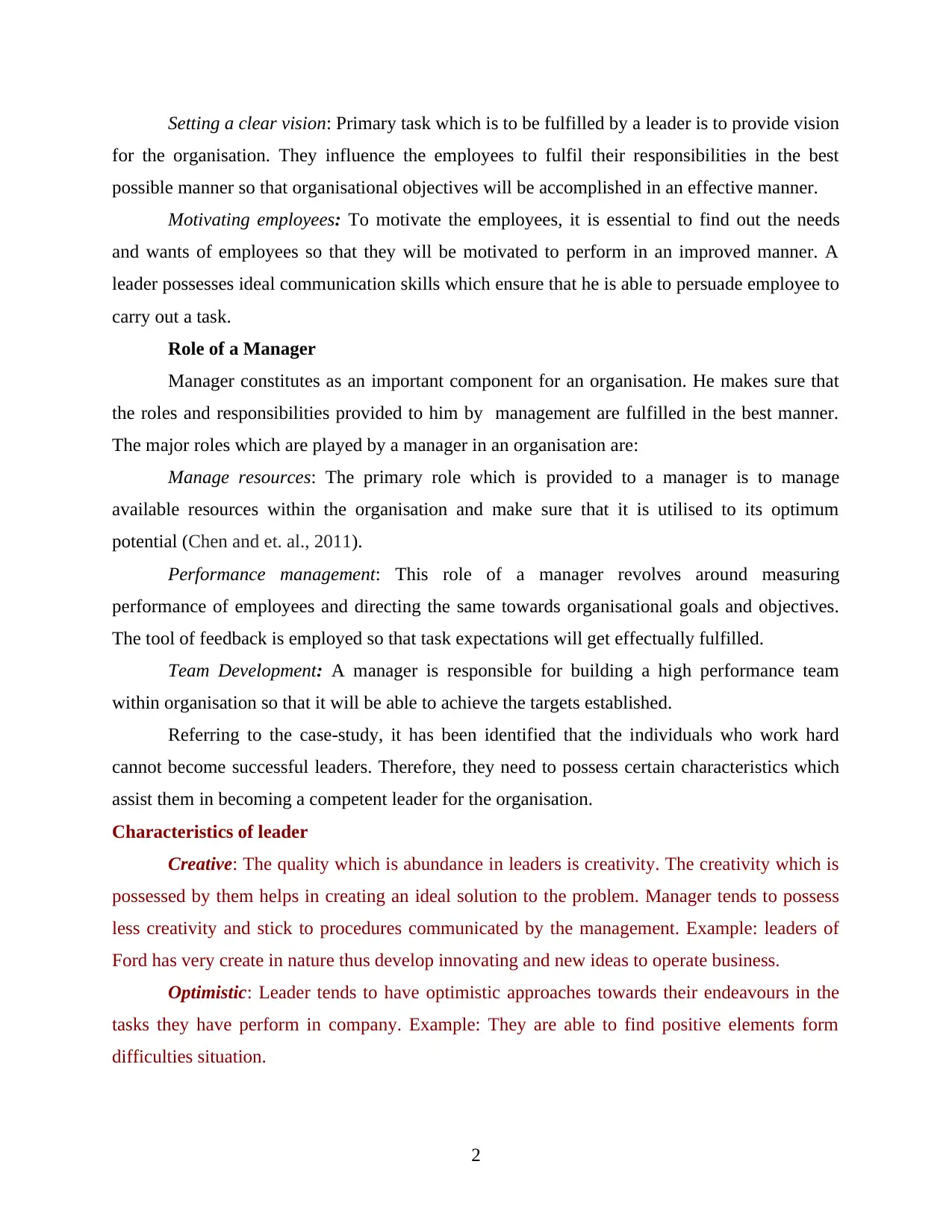
Setting a clear vision: Primary task which is to be fulfilled by a leader is to provide vision
for the organisation. They influence the employees to fulfil their responsibilities in the best
possible manner so that organisational objectives will be accomplished in an effective manner.
Motivating employees: To motivate the employees, it is essential to find out the needs
and wants of employees so that they will be motivated to perform in an improved manner. A
leader possesses ideal communication skills which ensure that he is able to persuade employee to
carry out a task.
Role of a Manager
Manager constitutes as an important component for an organisation. He makes sure that
the roles and responsibilities provided to him by management are fulfilled in the best manner.
The major roles which are played by a manager in an organisation are:
Manage resources: The primary role which is provided to a manager is to manage
available resources within the organisation and make sure that it is utilised to its optimum
potential (Chen and et. al., 2011).
Performance management: This role of a manager revolves around measuring
performance of employees and directing the same towards organisational goals and objectives.
The tool of feedback is employed so that task expectations will get effectually fulfilled.
Team Development: A manager is responsible for building a high performance team
within organisation so that it will be able to achieve the targets established.
Referring to the case-study, it has been identified that the individuals who work hard
cannot become successful leaders. Therefore, they need to possess certain characteristics which
assist them in becoming a competent leader for the organisation.
Characteristics of leader
Creative: The quality which is abundance in leaders is creativity. The creativity which is
possessed by them helps in creating an ideal solution to the problem. Manager tends to possess
less creativity and stick to procedures communicated by the management. Example: leaders of
Ford has very create in nature thus develop innovating and new ideas to operate business.
Optimistic: Leader tends to have optimistic approaches towards their endeavours in the
tasks they have perform in company. Example: They are able to find positive elements form
difficulties situation.
2
for the organisation. They influence the employees to fulfil their responsibilities in the best
possible manner so that organisational objectives will be accomplished in an effective manner.
Motivating employees: To motivate the employees, it is essential to find out the needs
and wants of employees so that they will be motivated to perform in an improved manner. A
leader possesses ideal communication skills which ensure that he is able to persuade employee to
carry out a task.
Role of a Manager
Manager constitutes as an important component for an organisation. He makes sure that
the roles and responsibilities provided to him by management are fulfilled in the best manner.
The major roles which are played by a manager in an organisation are:
Manage resources: The primary role which is provided to a manager is to manage
available resources within the organisation and make sure that it is utilised to its optimum
potential (Chen and et. al., 2011).
Performance management: This role of a manager revolves around measuring
performance of employees and directing the same towards organisational goals and objectives.
The tool of feedback is employed so that task expectations will get effectually fulfilled.
Team Development: A manager is responsible for building a high performance team
within organisation so that it will be able to achieve the targets established.
Referring to the case-study, it has been identified that the individuals who work hard
cannot become successful leaders. Therefore, they need to possess certain characteristics which
assist them in becoming a competent leader for the organisation.
Characteristics of leader
Creative: The quality which is abundance in leaders is creativity. The creativity which is
possessed by them helps in creating an ideal solution to the problem. Manager tends to possess
less creativity and stick to procedures communicated by the management. Example: leaders of
Ford has very create in nature thus develop innovating and new ideas to operate business.
Optimistic: Leader tends to have optimistic approaches towards their endeavours in the
tasks they have perform in company. Example: They are able to find positive elements form
difficulties situation.
2
Paraphrase This Document
Need a fresh take? Get an instant paraphrase of this document with our AI Paraphraser
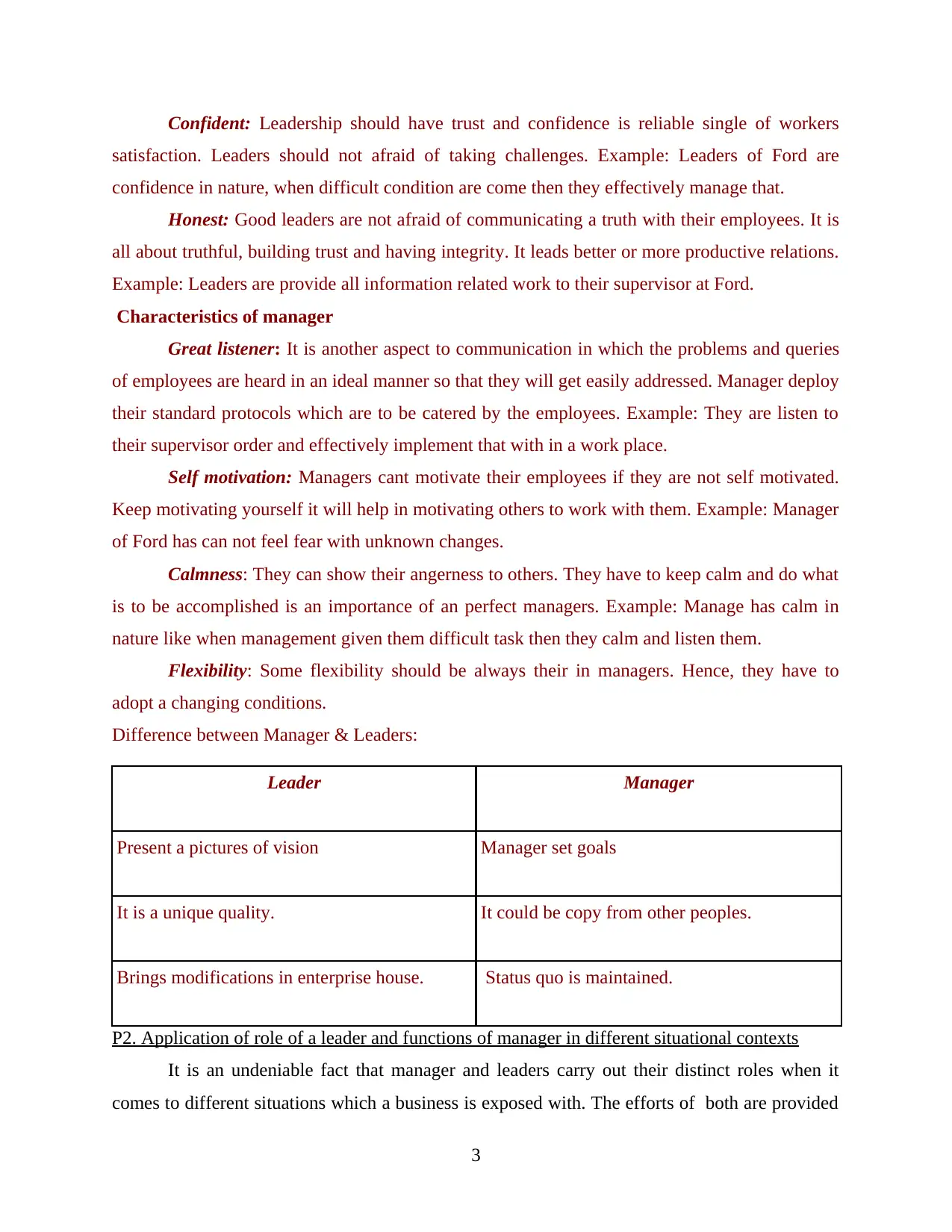
Confident: Leadership should have trust and confidence is reliable single of workers
satisfaction. Leaders should not afraid of taking challenges. Example: Leaders of Ford are
confidence in nature, when difficult condition are come then they effectively manage that.
Honest: Good leaders are not afraid of communicating a truth with their employees. It is
all about truthful, building trust and having integrity. It leads better or more productive relations.
Example: Leaders are provide all information related work to their supervisor at Ford.
Characteristics of manager
Great listener: It is another aspect to communication in which the problems and queries
of employees are heard in an ideal manner so that they will get easily addressed. Manager deploy
their standard protocols which are to be catered by the employees. Example: They are listen to
their supervisor order and effectively implement that with in a work place.
Self motivation: Managers cant motivate their employees if they are not self motivated.
Keep motivating yourself it will help in motivating others to work with them. Example: Manager
of Ford has can not feel fear with unknown changes.
Calmness: They can show their angerness to others. They have to keep calm and do what
is to be accomplished is an importance of an perfect managers. Example: Manage has calm in
nature like when management given them difficult task then they calm and listen them.
Flexibility: Some flexibility should be always their in managers. Hence, they have to
adopt a changing conditions.
Difference between Manager & Leaders:
Leader Manager
Present a pictures of vision Manager set goals
It is a unique quality. It could be copy from other peoples.
Brings modifications in enterprise house. Status quo is maintained.
P2. Application of role of a leader and functions of manager in different situational contexts
It is an undeniable fact that manager and leaders carry out their distinct roles when it
comes to different situations which a business is exposed with. The efforts of both are provided
3
satisfaction. Leaders should not afraid of taking challenges. Example: Leaders of Ford are
confidence in nature, when difficult condition are come then they effectively manage that.
Honest: Good leaders are not afraid of communicating a truth with their employees. It is
all about truthful, building trust and having integrity. It leads better or more productive relations.
Example: Leaders are provide all information related work to their supervisor at Ford.
Characteristics of manager
Great listener: It is another aspect to communication in which the problems and queries
of employees are heard in an ideal manner so that they will get easily addressed. Manager deploy
their standard protocols which are to be catered by the employees. Example: They are listen to
their supervisor order and effectively implement that with in a work place.
Self motivation: Managers cant motivate their employees if they are not self motivated.
Keep motivating yourself it will help in motivating others to work with them. Example: Manager
of Ford has can not feel fear with unknown changes.
Calmness: They can show their angerness to others. They have to keep calm and do what
is to be accomplished is an importance of an perfect managers. Example: Manage has calm in
nature like when management given them difficult task then they calm and listen them.
Flexibility: Some flexibility should be always their in managers. Hence, they have to
adopt a changing conditions.
Difference between Manager & Leaders:
Leader Manager
Present a pictures of vision Manager set goals
It is a unique quality. It could be copy from other peoples.
Brings modifications in enterprise house. Status quo is maintained.
P2. Application of role of a leader and functions of manager in different situational contexts
It is an undeniable fact that manager and leaders carry out their distinct roles when it
comes to different situations which a business is exposed with. The efforts of both are provided
3
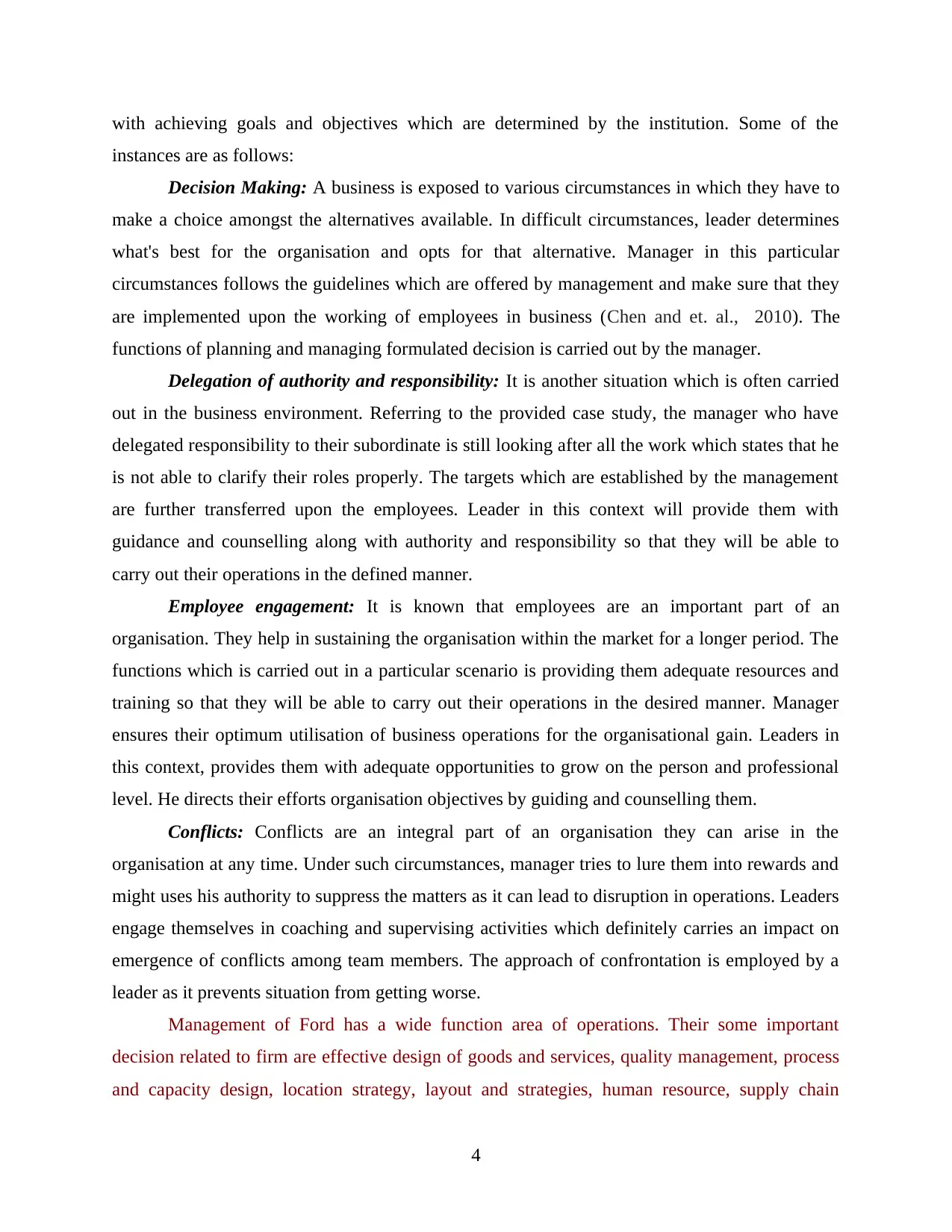
with achieving goals and objectives which are determined by the institution. Some of the
instances are as follows:
Decision Making: A business is exposed to various circumstances in which they have to
make a choice amongst the alternatives available. In difficult circumstances, leader determines
what's best for the organisation and opts for that alternative. Manager in this particular
circumstances follows the guidelines which are offered by management and make sure that they
are implemented upon the working of employees in business (Chen and et. al., 2010). The
functions of planning and managing formulated decision is carried out by the manager.
Delegation of authority and responsibility: It is another situation which is often carried
out in the business environment. Referring to the provided case study, the manager who have
delegated responsibility to their subordinate is still looking after all the work which states that he
is not able to clarify their roles properly. The targets which are established by the management
are further transferred upon the employees. Leader in this context will provide them with
guidance and counselling along with authority and responsibility so that they will be able to
carry out their operations in the defined manner.
Employee engagement: It is known that employees are an important part of an
organisation. They help in sustaining the organisation within the market for a longer period. The
functions which is carried out in a particular scenario is providing them adequate resources and
training so that they will be able to carry out their operations in the desired manner. Manager
ensures their optimum utilisation of business operations for the organisational gain. Leaders in
this context, provides them with adequate opportunities to grow on the person and professional
level. He directs their efforts organisation objectives by guiding and counselling them.
Conflicts: Conflicts are an integral part of an organisation they can arise in the
organisation at any time. Under such circumstances, manager tries to lure them into rewards and
might uses his authority to suppress the matters as it can lead to disruption in operations. Leaders
engage themselves in coaching and supervising activities which definitely carries an impact on
emergence of conflicts among team members. The approach of confrontation is employed by a
leader as it prevents situation from getting worse.
Management of Ford has a wide function area of operations. Their some important
decision related to firm are effective design of goods and services, quality management, process
and capacity design, location strategy, layout and strategies, human resource, supply chain
4
instances are as follows:
Decision Making: A business is exposed to various circumstances in which they have to
make a choice amongst the alternatives available. In difficult circumstances, leader determines
what's best for the organisation and opts for that alternative. Manager in this particular
circumstances follows the guidelines which are offered by management and make sure that they
are implemented upon the working of employees in business (Chen and et. al., 2010). The
functions of planning and managing formulated decision is carried out by the manager.
Delegation of authority and responsibility: It is another situation which is often carried
out in the business environment. Referring to the provided case study, the manager who have
delegated responsibility to their subordinate is still looking after all the work which states that he
is not able to clarify their roles properly. The targets which are established by the management
are further transferred upon the employees. Leader in this context will provide them with
guidance and counselling along with authority and responsibility so that they will be able to
carry out their operations in the defined manner.
Employee engagement: It is known that employees are an important part of an
organisation. They help in sustaining the organisation within the market for a longer period. The
functions which is carried out in a particular scenario is providing them adequate resources and
training so that they will be able to carry out their operations in the desired manner. Manager
ensures their optimum utilisation of business operations for the organisational gain. Leaders in
this context, provides them with adequate opportunities to grow on the person and professional
level. He directs their efforts organisation objectives by guiding and counselling them.
Conflicts: Conflicts are an integral part of an organisation they can arise in the
organisation at any time. Under such circumstances, manager tries to lure them into rewards and
might uses his authority to suppress the matters as it can lead to disruption in operations. Leaders
engage themselves in coaching and supervising activities which definitely carries an impact on
emergence of conflicts among team members. The approach of confrontation is employed by a
leader as it prevents situation from getting worse.
Management of Ford has a wide function area of operations. Their some important
decision related to firm are effective design of goods and services, quality management, process
and capacity design, location strategy, layout and strategies, human resource, supply chain
4
⊘ This is a preview!⊘
Do you want full access?
Subscribe today to unlock all pages.

Trusted by 1+ million students worldwide
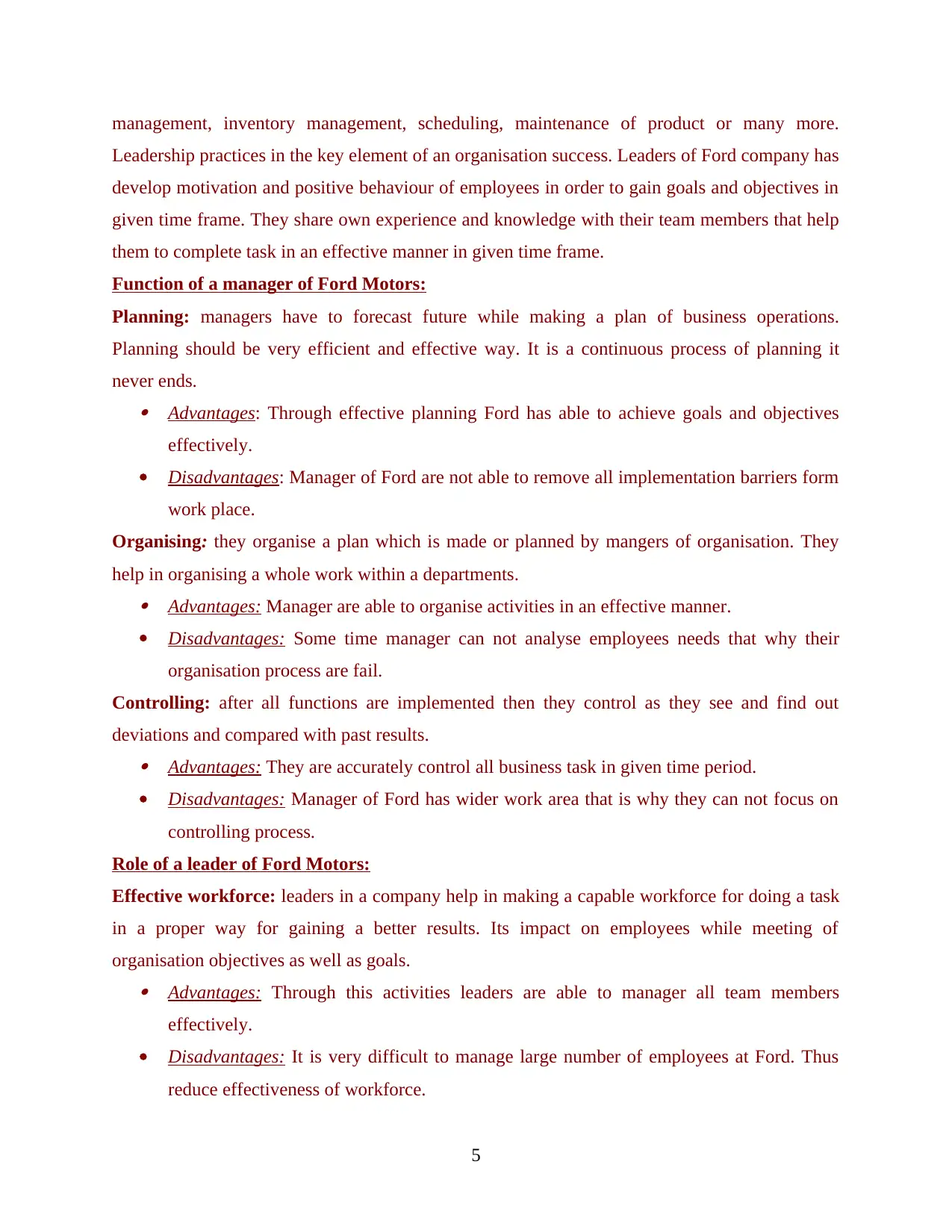
management, inventory management, scheduling, maintenance of product or many more.
Leadership practices in the key element of an organisation success. Leaders of Ford company has
develop motivation and positive behaviour of employees in order to gain goals and objectives in
given time frame. They share own experience and knowledge with their team members that help
them to complete task in an effective manner in given time frame.
Function of a manager of Ford Motors:
Planning: managers have to forecast future while making a plan of business operations.
Planning should be very efficient and effective way. It is a continuous process of planning it
never ends. Advantages: Through effective planning Ford has able to achieve goals and objectives
effectively.
Disadvantages: Manager of Ford are not able to remove all implementation barriers form
work place.
Organising: they organise a plan which is made or planned by mangers of organisation. They
help in organising a whole work within a departments. Advantages: Manager are able to organise activities in an effective manner.
Disadvantages: Some time manager can not analyse employees needs that why their
organisation process are fail.
Controlling: after all functions are implemented then they control as they see and find out
deviations and compared with past results. Advantages: They are accurately control all business task in given time period.
Disadvantages: Manager of Ford has wider work area that is why they can not focus on
controlling process.
Role of a leader of Ford Motors:
Effective workforce: leaders in a company help in making a capable workforce for doing a task
in a proper way for gaining a better results. Its impact on employees while meeting of
organisation objectives as well as goals. Advantages: Through this activities leaders are able to manager all team members
effectively.
Disadvantages: It is very difficult to manage large number of employees at Ford. Thus
reduce effectiveness of workforce.
5
Leadership practices in the key element of an organisation success. Leaders of Ford company has
develop motivation and positive behaviour of employees in order to gain goals and objectives in
given time frame. They share own experience and knowledge with their team members that help
them to complete task in an effective manner in given time frame.
Function of a manager of Ford Motors:
Planning: managers have to forecast future while making a plan of business operations.
Planning should be very efficient and effective way. It is a continuous process of planning it
never ends. Advantages: Through effective planning Ford has able to achieve goals and objectives
effectively.
Disadvantages: Manager of Ford are not able to remove all implementation barriers form
work place.
Organising: they organise a plan which is made or planned by mangers of organisation. They
help in organising a whole work within a departments. Advantages: Manager are able to organise activities in an effective manner.
Disadvantages: Some time manager can not analyse employees needs that why their
organisation process are fail.
Controlling: after all functions are implemented then they control as they see and find out
deviations and compared with past results. Advantages: They are accurately control all business task in given time period.
Disadvantages: Manager of Ford has wider work area that is why they can not focus on
controlling process.
Role of a leader of Ford Motors:
Effective workforce: leaders in a company help in making a capable workforce for doing a task
in a proper way for gaining a better results. Its impact on employees while meeting of
organisation objectives as well as goals. Advantages: Through this activities leaders are able to manager all team members
effectively.
Disadvantages: It is very difficult to manage large number of employees at Ford. Thus
reduce effectiveness of workforce.
5
Paraphrase This Document
Need a fresh take? Get an instant paraphrase of this document with our AI Paraphraser
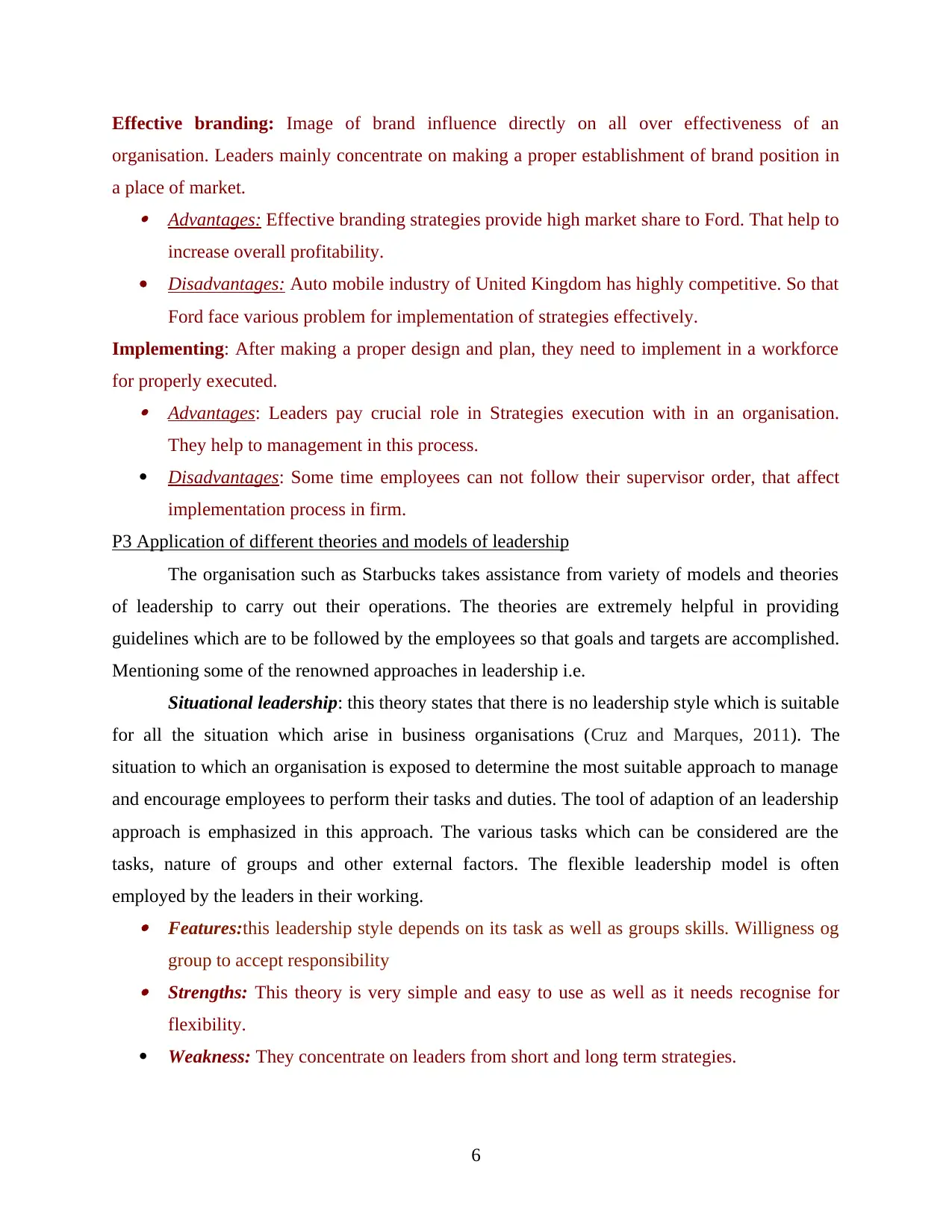
Effective branding: Image of brand influence directly on all over effectiveness of an
organisation. Leaders mainly concentrate on making a proper establishment of brand position in
a place of market. Advantages: Effective branding strategies provide high market share to Ford. That help to
increase overall profitability.
Disadvantages: Auto mobile industry of United Kingdom has highly competitive. So that
Ford face various problem for implementation of strategies effectively.
Implementing: After making a proper design and plan, they need to implement in a workforce
for properly executed. Advantages: Leaders pay crucial role in Strategies execution with in an organisation.
They help to management in this process.
Disadvantages: Some time employees can not follow their supervisor order, that affect
implementation process in firm.
P3 Application of different theories and models of leadership
The organisation such as Starbucks takes assistance from variety of models and theories
of leadership to carry out their operations. The theories are extremely helpful in providing
guidelines which are to be followed by the employees so that goals and targets are accomplished.
Mentioning some of the renowned approaches in leadership i.e.
Situational leadership: this theory states that there is no leadership style which is suitable
for all the situation which arise in business organisations (Cruz and Marques, 2011). The
situation to which an organisation is exposed to determine the most suitable approach to manage
and encourage employees to perform their tasks and duties. The tool of adaption of an leadership
approach is emphasized in this approach. The various tasks which can be considered are the
tasks, nature of groups and other external factors. The flexible leadership model is often
employed by the leaders in their working. Features:this leadership style depends on its task as well as groups skills. Willigness og
group to accept responsibility Strengths: This theory is very simple and easy to use as well as it needs recognise for
flexibility.
Weakness: They concentrate on leaders from short and long term strategies.
6
organisation. Leaders mainly concentrate on making a proper establishment of brand position in
a place of market. Advantages: Effective branding strategies provide high market share to Ford. That help to
increase overall profitability.
Disadvantages: Auto mobile industry of United Kingdom has highly competitive. So that
Ford face various problem for implementation of strategies effectively.
Implementing: After making a proper design and plan, they need to implement in a workforce
for properly executed. Advantages: Leaders pay crucial role in Strategies execution with in an organisation.
They help to management in this process.
Disadvantages: Some time employees can not follow their supervisor order, that affect
implementation process in firm.
P3 Application of different theories and models of leadership
The organisation such as Starbucks takes assistance from variety of models and theories
of leadership to carry out their operations. The theories are extremely helpful in providing
guidelines which are to be followed by the employees so that goals and targets are accomplished.
Mentioning some of the renowned approaches in leadership i.e.
Situational leadership: this theory states that there is no leadership style which is suitable
for all the situation which arise in business organisations (Cruz and Marques, 2011). The
situation to which an organisation is exposed to determine the most suitable approach to manage
and encourage employees to perform their tasks and duties. The tool of adaption of an leadership
approach is emphasized in this approach. The various tasks which can be considered are the
tasks, nature of groups and other external factors. The flexible leadership model is often
employed by the leaders in their working. Features:this leadership style depends on its task as well as groups skills. Willigness og
group to accept responsibility Strengths: This theory is very simple and easy to use as well as it needs recognise for
flexibility.
Weakness: They concentrate on leaders from short and long term strategies.
6
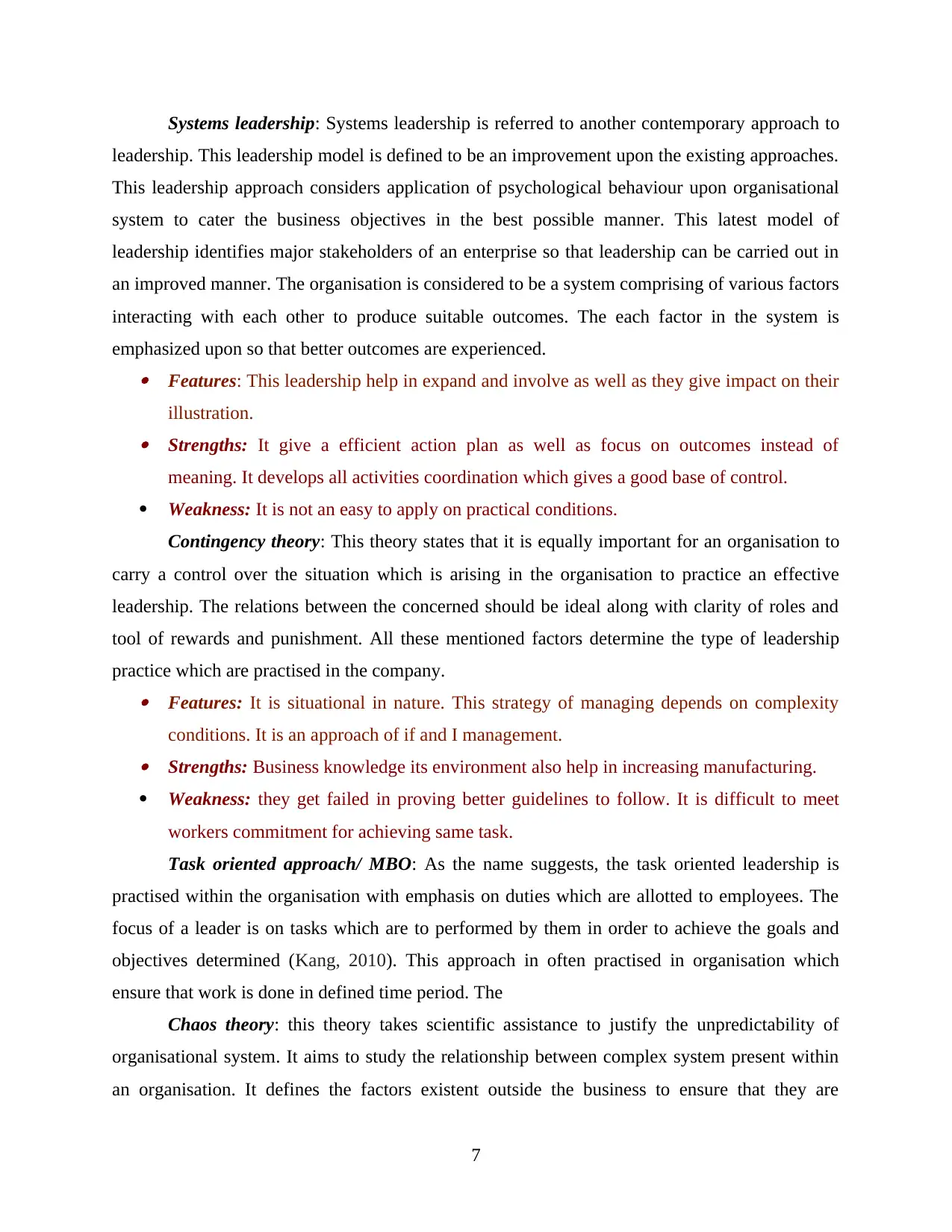
Systems leadership: Systems leadership is referred to another contemporary approach to
leadership. This leadership model is defined to be an improvement upon the existing approaches.
This leadership approach considers application of psychological behaviour upon organisational
system to cater the business objectives in the best possible manner. This latest model of
leadership identifies major stakeholders of an enterprise so that leadership can be carried out in
an improved manner. The organisation is considered to be a system comprising of various factors
interacting with each other to produce suitable outcomes. The each factor in the system is
emphasized upon so that better outcomes are experienced. Features: This leadership help in expand and involve as well as they give impact on their
illustration. Strengths: It give a efficient action plan as well as focus on outcomes instead of
meaning. It develops all activities coordination which gives a good base of control.
Weakness: It is not an easy to apply on practical conditions.
Contingency theory: This theory states that it is equally important for an organisation to
carry a control over the situation which is arising in the organisation to practice an effective
leadership. The relations between the concerned should be ideal along with clarity of roles and
tool of rewards and punishment. All these mentioned factors determine the type of leadership
practice which are practised in the company. Features: It is situational in nature. This strategy of managing depends on complexity
conditions. It is an approach of if and I management. Strengths: Business knowledge its environment also help in increasing manufacturing.
Weakness: they get failed in proving better guidelines to follow. It is difficult to meet
workers commitment for achieving same task.
Task oriented approach/ MBO: As the name suggests, the task oriented leadership is
practised within the organisation with emphasis on duties which are allotted to employees. The
focus of a leader is on tasks which are to performed by them in order to achieve the goals and
objectives determined (Kang, 2010). This approach in often practised in organisation which
ensure that work is done in defined time period. The
Chaos theory: this theory takes scientific assistance to justify the unpredictability of
organisational system. It aims to study the relationship between complex system present within
an organisation. It defines the factors existent outside the business to ensure that they are
7
leadership. This leadership model is defined to be an improvement upon the existing approaches.
This leadership approach considers application of psychological behaviour upon organisational
system to cater the business objectives in the best possible manner. This latest model of
leadership identifies major stakeholders of an enterprise so that leadership can be carried out in
an improved manner. The organisation is considered to be a system comprising of various factors
interacting with each other to produce suitable outcomes. The each factor in the system is
emphasized upon so that better outcomes are experienced. Features: This leadership help in expand and involve as well as they give impact on their
illustration. Strengths: It give a efficient action plan as well as focus on outcomes instead of
meaning. It develops all activities coordination which gives a good base of control.
Weakness: It is not an easy to apply on practical conditions.
Contingency theory: This theory states that it is equally important for an organisation to
carry a control over the situation which is arising in the organisation to practice an effective
leadership. The relations between the concerned should be ideal along with clarity of roles and
tool of rewards and punishment. All these mentioned factors determine the type of leadership
practice which are practised in the company. Features: It is situational in nature. This strategy of managing depends on complexity
conditions. It is an approach of if and I management. Strengths: Business knowledge its environment also help in increasing manufacturing.
Weakness: they get failed in proving better guidelines to follow. It is difficult to meet
workers commitment for achieving same task.
Task oriented approach/ MBO: As the name suggests, the task oriented leadership is
practised within the organisation with emphasis on duties which are allotted to employees. The
focus of a leader is on tasks which are to performed by them in order to achieve the goals and
objectives determined (Kang, 2010). This approach in often practised in organisation which
ensure that work is done in defined time period. The
Chaos theory: this theory takes scientific assistance to justify the unpredictability of
organisational system. It aims to study the relationship between complex system present within
an organisation. It defines the factors existent outside the business to ensure that they are
7
⊘ This is a preview!⊘
Do you want full access?
Subscribe today to unlock all pages.

Trusted by 1+ million students worldwide
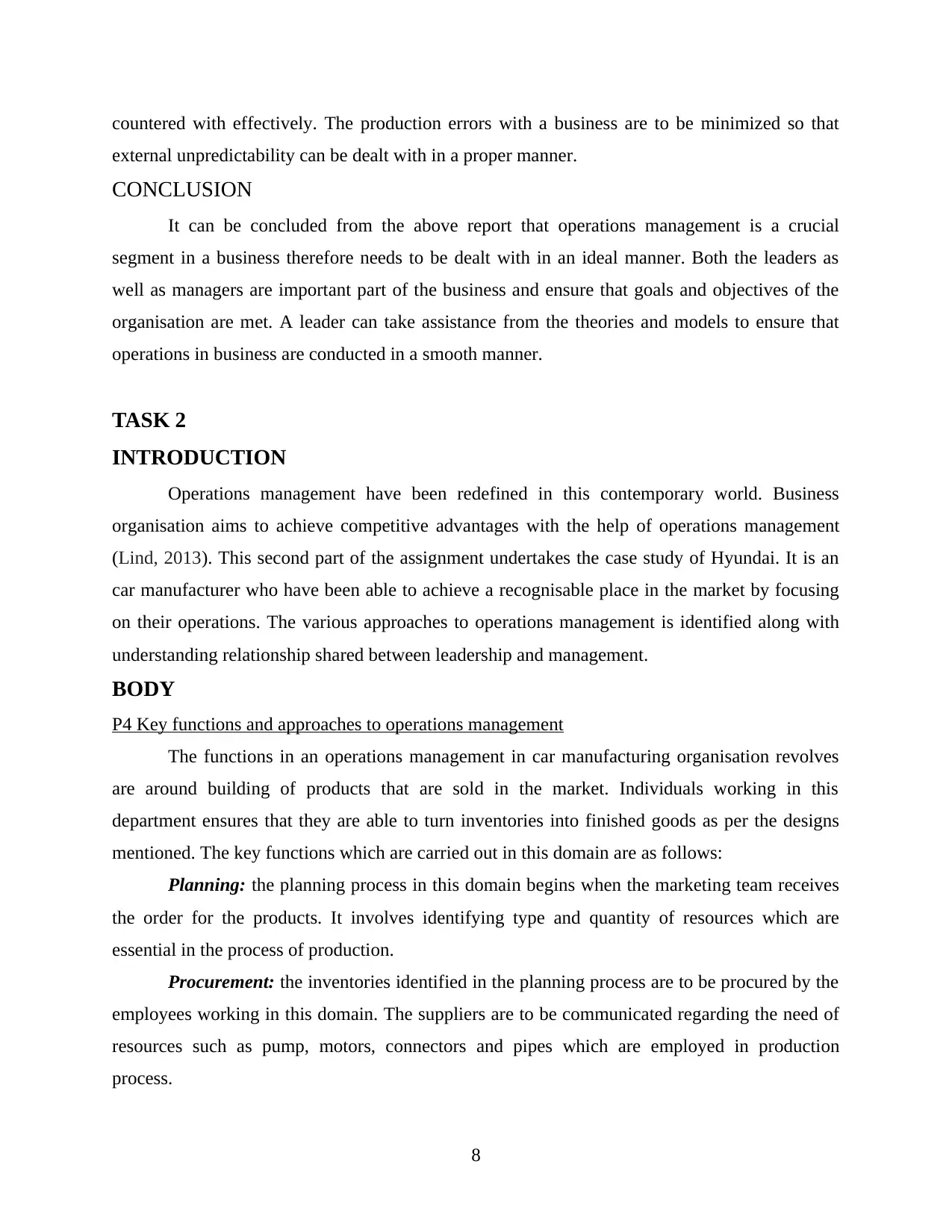
countered with effectively. The production errors with a business are to be minimized so that
external unpredictability can be dealt with in a proper manner.
CONCLUSION
It can be concluded from the above report that operations management is a crucial
segment in a business therefore needs to be dealt with in an ideal manner. Both the leaders as
well as managers are important part of the business and ensure that goals and objectives of the
organisation are met. A leader can take assistance from the theories and models to ensure that
operations in business are conducted in a smooth manner.
TASK 2
INTRODUCTION
Operations management have been redefined in this contemporary world. Business
organisation aims to achieve competitive advantages with the help of operations management
(Lind, 2013). This second part of the assignment undertakes the case study of Hyundai. It is an
car manufacturer who have been able to achieve a recognisable place in the market by focusing
on their operations. The various approaches to operations management is identified along with
understanding relationship shared between leadership and management.
BODY
P4 Key functions and approaches to operations management
The functions in an operations management in car manufacturing organisation revolves
are around building of products that are sold in the market. Individuals working in this
department ensures that they are able to turn inventories into finished goods as per the designs
mentioned. The key functions which are carried out in this domain are as follows:
Planning: the planning process in this domain begins when the marketing team receives
the order for the products. It involves identifying type and quantity of resources which are
essential in the process of production.
Procurement: the inventories identified in the planning process are to be procured by the
employees working in this domain. The suppliers are to be communicated regarding the need of
resources such as pump, motors, connectors and pipes which are employed in production
process.
8
external unpredictability can be dealt with in a proper manner.
CONCLUSION
It can be concluded from the above report that operations management is a crucial
segment in a business therefore needs to be dealt with in an ideal manner. Both the leaders as
well as managers are important part of the business and ensure that goals and objectives of the
organisation are met. A leader can take assistance from the theories and models to ensure that
operations in business are conducted in a smooth manner.
TASK 2
INTRODUCTION
Operations management have been redefined in this contemporary world. Business
organisation aims to achieve competitive advantages with the help of operations management
(Lind, 2013). This second part of the assignment undertakes the case study of Hyundai. It is an
car manufacturer who have been able to achieve a recognisable place in the market by focusing
on their operations. The various approaches to operations management is identified along with
understanding relationship shared between leadership and management.
BODY
P4 Key functions and approaches to operations management
The functions in an operations management in car manufacturing organisation revolves
are around building of products that are sold in the market. Individuals working in this
department ensures that they are able to turn inventories into finished goods as per the designs
mentioned. The key functions which are carried out in this domain are as follows:
Planning: the planning process in this domain begins when the marketing team receives
the order for the products. It involves identifying type and quantity of resources which are
essential in the process of production.
Procurement: the inventories identified in the planning process are to be procured by the
employees working in this domain. The suppliers are to be communicated regarding the need of
resources such as pump, motors, connectors and pipes which are employed in production
process.
8
Paraphrase This Document
Need a fresh take? Get an instant paraphrase of this document with our AI Paraphraser
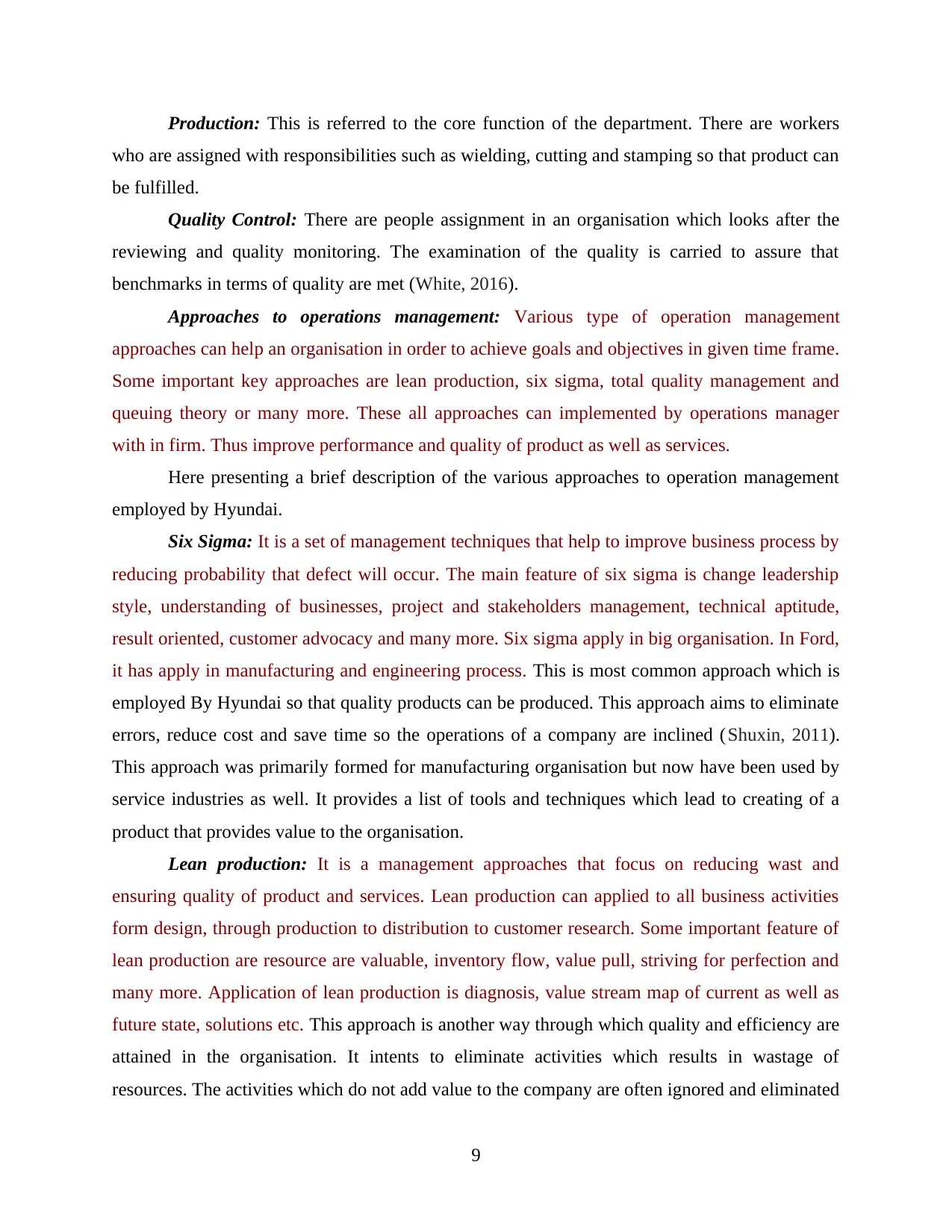
Production: This is referred to the core function of the department. There are workers
who are assigned with responsibilities such as wielding, cutting and stamping so that product can
be fulfilled.
Quality Control: There are people assignment in an organisation which looks after the
reviewing and quality monitoring. The examination of the quality is carried to assure that
benchmarks in terms of quality are met (White, 2016).
Approaches to operations management: Various type of operation management
approaches can help an organisation in order to achieve goals and objectives in given time frame.
Some important key approaches are lean production, six sigma, total quality management and
queuing theory or many more. These all approaches can implemented by operations manager
with in firm. Thus improve performance and quality of product as well as services.
Here presenting a brief description of the various approaches to operation management
employed by Hyundai.
Six Sigma: It is a set of management techniques that help to improve business process by
reducing probability that defect will occur. The main feature of six sigma is change leadership
style, understanding of businesses, project and stakeholders management, technical aptitude,
result oriented, customer advocacy and many more. Six sigma apply in big organisation. In Ford,
it has apply in manufacturing and engineering process. This is most common approach which is
employed By Hyundai so that quality products can be produced. This approach aims to eliminate
errors, reduce cost and save time so the operations of a company are inclined (Shuxin, 2011).
This approach was primarily formed for manufacturing organisation but now have been used by
service industries as well. It provides a list of tools and techniques which lead to creating of a
product that provides value to the organisation.
Lean production: It is a management approaches that focus on reducing wast and
ensuring quality of product and services. Lean production can applied to all business activities
form design, through production to distribution to customer research. Some important feature of
lean production are resource are valuable, inventory flow, value pull, striving for perfection and
many more. Application of lean production is diagnosis, value stream map of current as well as
future state, solutions etc. This approach is another way through which quality and efficiency are
attained in the organisation. It intents to eliminate activities which results in wastage of
resources. The activities which do not add value to the company are often ignored and eliminated
9
who are assigned with responsibilities such as wielding, cutting and stamping so that product can
be fulfilled.
Quality Control: There are people assignment in an organisation which looks after the
reviewing and quality monitoring. The examination of the quality is carried to assure that
benchmarks in terms of quality are met (White, 2016).
Approaches to operations management: Various type of operation management
approaches can help an organisation in order to achieve goals and objectives in given time frame.
Some important key approaches are lean production, six sigma, total quality management and
queuing theory or many more. These all approaches can implemented by operations manager
with in firm. Thus improve performance and quality of product as well as services.
Here presenting a brief description of the various approaches to operation management
employed by Hyundai.
Six Sigma: It is a set of management techniques that help to improve business process by
reducing probability that defect will occur. The main feature of six sigma is change leadership
style, understanding of businesses, project and stakeholders management, technical aptitude,
result oriented, customer advocacy and many more. Six sigma apply in big organisation. In Ford,
it has apply in manufacturing and engineering process. This is most common approach which is
employed By Hyundai so that quality products can be produced. This approach aims to eliminate
errors, reduce cost and save time so the operations of a company are inclined (Shuxin, 2011).
This approach was primarily formed for manufacturing organisation but now have been used by
service industries as well. It provides a list of tools and techniques which lead to creating of a
product that provides value to the organisation.
Lean production: It is a management approaches that focus on reducing wast and
ensuring quality of product and services. Lean production can applied to all business activities
form design, through production to distribution to customer research. Some important feature of
lean production are resource are valuable, inventory flow, value pull, striving for perfection and
many more. Application of lean production is diagnosis, value stream map of current as well as
future state, solutions etc. This approach is another way through which quality and efficiency are
attained in the organisation. It intents to eliminate activities which results in wastage of
resources. The activities which do not add value to the company are often ignored and eliminated
9
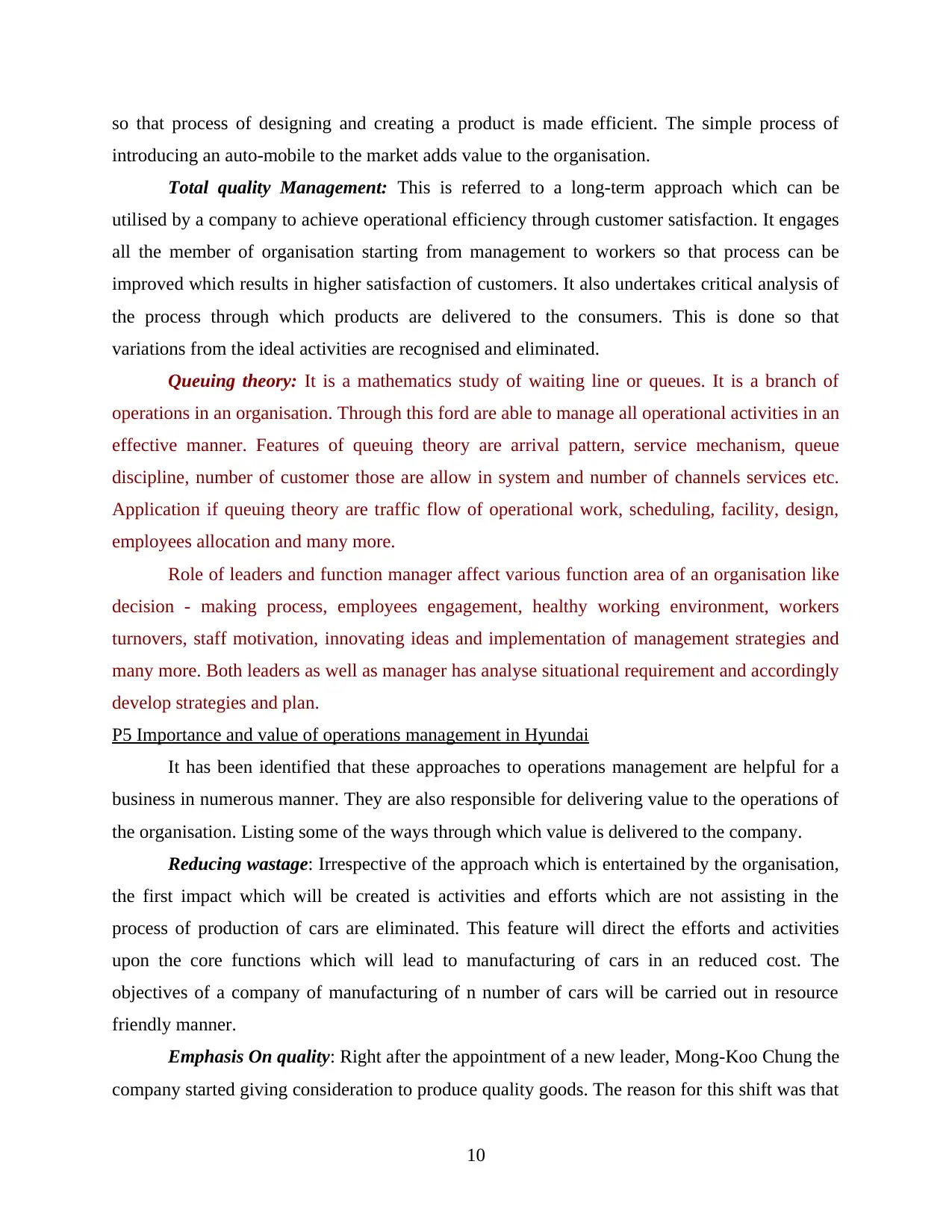
so that process of designing and creating a product is made efficient. The simple process of
introducing an auto-mobile to the market adds value to the organisation.
Total quality Management: This is referred to a long-term approach which can be
utilised by a company to achieve operational efficiency through customer satisfaction. It engages
all the member of organisation starting from management to workers so that process can be
improved which results in higher satisfaction of customers. It also undertakes critical analysis of
the process through which products are delivered to the consumers. This is done so that
variations from the ideal activities are recognised and eliminated.
Queuing theory: It is a mathematics study of waiting line or queues. It is a branch of
operations in an organisation. Through this ford are able to manage all operational activities in an
effective manner. Features of queuing theory are arrival pattern, service mechanism, queue
discipline, number of customer those are allow in system and number of channels services etc.
Application if queuing theory are traffic flow of operational work, scheduling, facility, design,
employees allocation and many more.
Role of leaders and function manager affect various function area of an organisation like
decision - making process, employees engagement, healthy working environment, workers
turnovers, staff motivation, innovating ideas and implementation of management strategies and
many more. Both leaders as well as manager has analyse situational requirement and accordingly
develop strategies and plan.
P5 Importance and value of operations management in Hyundai
It has been identified that these approaches to operations management are helpful for a
business in numerous manner. They are also responsible for delivering value to the operations of
the organisation. Listing some of the ways through which value is delivered to the company.
Reducing wastage: Irrespective of the approach which is entertained by the organisation,
the first impact which will be created is activities and efforts which are not assisting in the
process of production of cars are eliminated. This feature will direct the efforts and activities
upon the core functions which will lead to manufacturing of cars in an reduced cost. The
objectives of a company of manufacturing of n number of cars will be carried out in resource
friendly manner.
Emphasis On quality: Right after the appointment of a new leader, Mong-Koo Chung the
company started giving consideration to produce quality goods. The reason for this shift was that
10
introducing an auto-mobile to the market adds value to the organisation.
Total quality Management: This is referred to a long-term approach which can be
utilised by a company to achieve operational efficiency through customer satisfaction. It engages
all the member of organisation starting from management to workers so that process can be
improved which results in higher satisfaction of customers. It also undertakes critical analysis of
the process through which products are delivered to the consumers. This is done so that
variations from the ideal activities are recognised and eliminated.
Queuing theory: It is a mathematics study of waiting line or queues. It is a branch of
operations in an organisation. Through this ford are able to manage all operational activities in an
effective manner. Features of queuing theory are arrival pattern, service mechanism, queue
discipline, number of customer those are allow in system and number of channels services etc.
Application if queuing theory are traffic flow of operational work, scheduling, facility, design,
employees allocation and many more.
Role of leaders and function manager affect various function area of an organisation like
decision - making process, employees engagement, healthy working environment, workers
turnovers, staff motivation, innovating ideas and implementation of management strategies and
many more. Both leaders as well as manager has analyse situational requirement and accordingly
develop strategies and plan.
P5 Importance and value of operations management in Hyundai
It has been identified that these approaches to operations management are helpful for a
business in numerous manner. They are also responsible for delivering value to the operations of
the organisation. Listing some of the ways through which value is delivered to the company.
Reducing wastage: Irrespective of the approach which is entertained by the organisation,
the first impact which will be created is activities and efforts which are not assisting in the
process of production of cars are eliminated. This feature will direct the efforts and activities
upon the core functions which will lead to manufacturing of cars in an reduced cost. The
objectives of a company of manufacturing of n number of cars will be carried out in resource
friendly manner.
Emphasis On quality: Right after the appointment of a new leader, Mong-Koo Chung the
company started giving consideration to produce quality goods. The reason for this shift was that
10
⊘ This is a preview!⊘
Do you want full access?
Subscribe today to unlock all pages.

Trusted by 1+ million students worldwide
1 out of 16
Related Documents
Your All-in-One AI-Powered Toolkit for Academic Success.
+13062052269
info@desklib.com
Available 24*7 on WhatsApp / Email
![[object Object]](/_next/static/media/star-bottom.7253800d.svg)
Unlock your academic potential
Copyright © 2020–2025 A2Z Services. All Rights Reserved. Developed and managed by ZUCOL.





